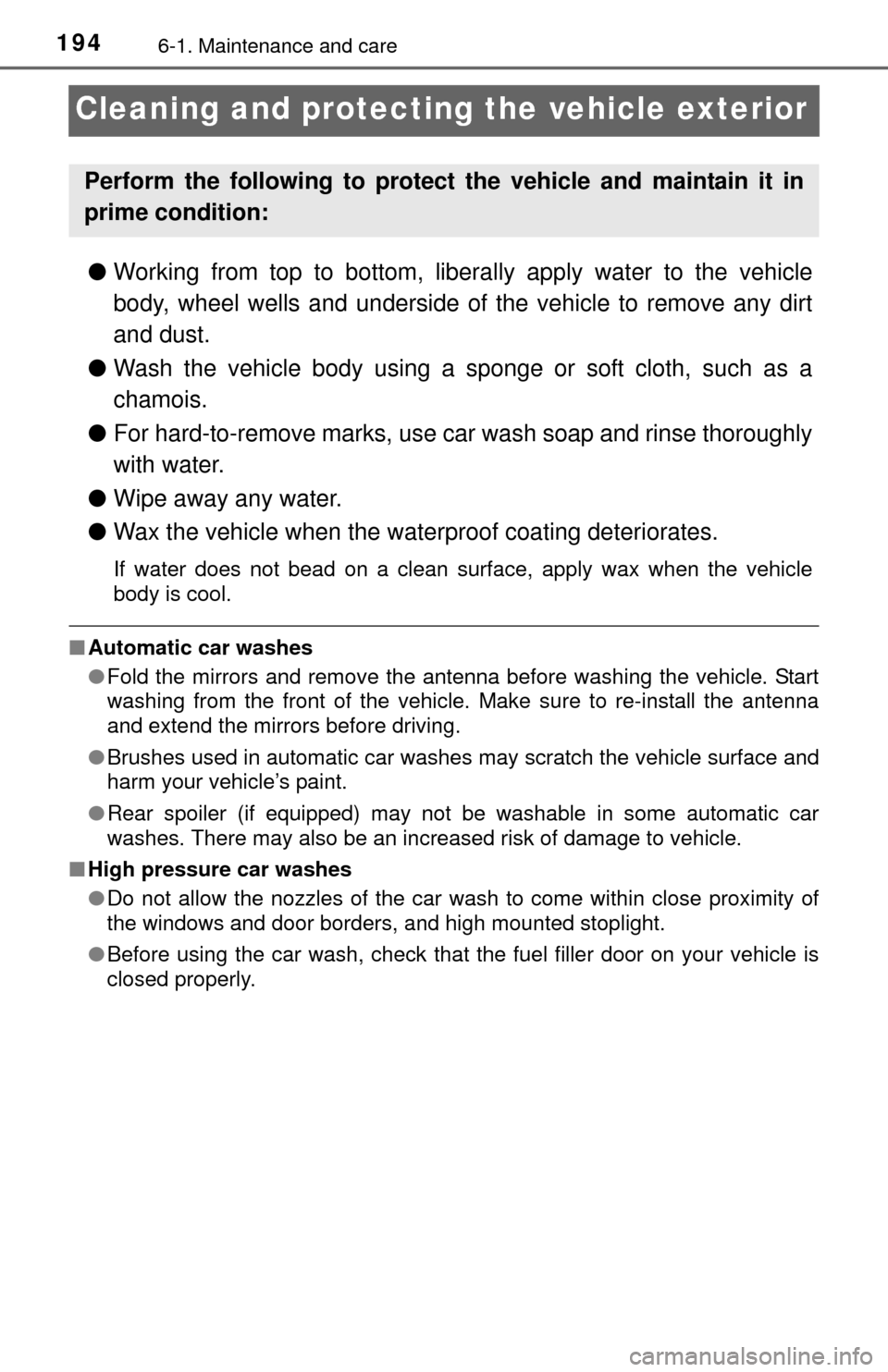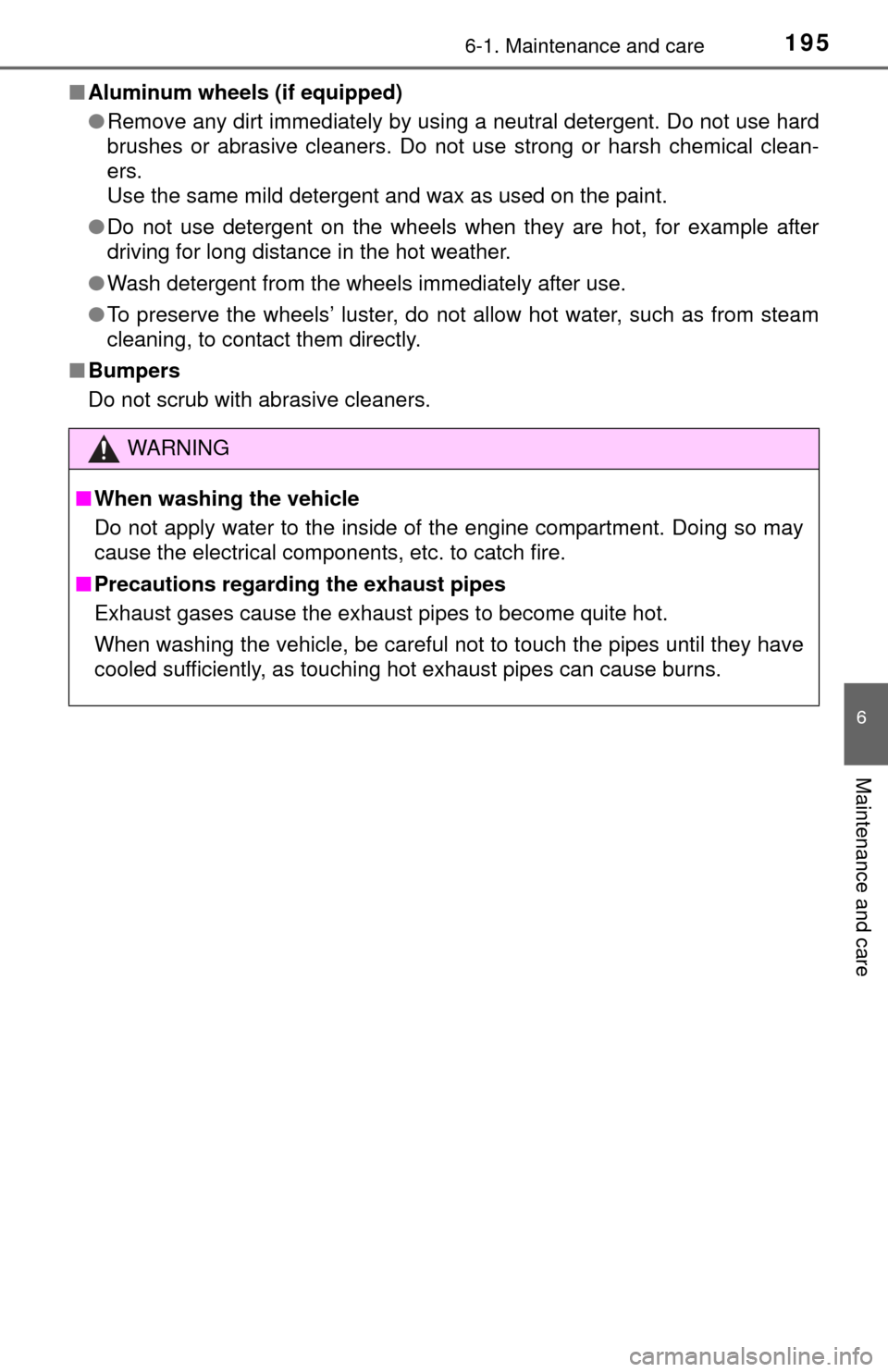Page 1 of 364
Pictorial indexSearch by illustration
1For safety
and securityMake sure to read through them
2Instrument
clusterHow to read the gauges and meters, the variety of
warning lights and indicators, etc.
3
Operation of
each
componentOpening and closing the doors and windows,
adjustment before driving, etc.
4DrivingOperations and advices which are necessary for
driving
5Interior featuresUsage of the interior features, etc.
6Maintenance
and careCaring for your vehicle and maintenance
procedures
7When trouble
arisesWhat to do in case of malfunction or emergency
8Vehicle
specificationsVehicle specifications, customizable features, etc.
9For ownersReporting safety defects for U.S. owners, and seat
belt and SRS airbag instructions for Canadian
owners
IndexSearch by symptom
Search alphabetically
Page 4 of 364

TABLE OF CONTENTS4
6-1. Maintenance and careCleaning and protecting the vehicle exterior .......... 194
Cleaning and protecting the vehicle interior ........... 197
6-2. Maintenance Maintenance requirements ................... 200
General maintenance ........ 202
Emission inspection and maintenance (I/M)
program........................... 205
6-3. Do-it-yourself maintenance Do-it-yourself service precautions ..................... 206
Hood.................................. 209
Positioning a floor jack ...... 211
Engine compartment ......... 213
Tires .................................. 223
Tire inflation pressure........ 231
Wheels .............................. 235
Air conditioning filter .......... 238
Wireless remote control battery ............................. 240
Checking and replacing fuses ............................... 243
Light bulbs ......................... 248 7-1. Essential information
Emergency flashers ........... 262
If your vehicle has to be stopped in
an emergency.................. 263
7-2. Steps to take in an emergency
If your vehicle needs to be towed .......................... 265
If you think something is wrong............................... 270
Fuel pump shut off system ............................. 271
If a warning light turns on or a warning buzzer
sounds ............................. 272
If you have a flat tire .......... 281
If the engine will not start ... 294
If the shift lever cannot be shifted from P (vehicles
with an automatic
transmission) ................... 296
If the vehicle battery is discharged ....................... 297
If your vehicle overheats.... 300
If the vehicle becomes stuck ................................ 303
6Maintenance and care7When trouble arises
Page 5 of 364
5
1
8 7 5 4
3
2
9
6
8-1. SpecificationsMaintenance data (fuel, oil level, etc.) .......... 306
Fuel information ................ 317
Tire information ................. 320
8-2. Customization Customizable features ...... 333
Items to initialize................ 335
Reporting safety defects for U.S. owners ........................ 338
Seat belt instructions for Canadian owners
(in French) ............................... 339
SRS airbag instructions for Canadian owners
(in French) .............................. 341
What to do if... (Troubleshooting) .................... 352
Alphabetical index...................... 355
8Vehicle specifications
9For owners
Index
Page 67 of 364
671-2. Theft deterrent system
1
For safety and security
Engine immobilizer system
The system begins operating after the key has been removed from
the engine switch. The system is canceled after the registered key
has been inserted into the engine switch.
■ System maintenance
The vehicle has a maintenance-free type engine immobilizer system.
■ Conditions that may cause the system to malfunction
●If the grip portion of the key is in contact with a metallic object
● If the key is in close proximity to or touching a key to the security system
(key with a built-in transponder chip) of another vehicle
: If equipped
The vehicle’s keys have built-in transponder chips that prevent
the engine from starting if a key has not been previously regis-
tered in the vehicle’s on-board computer.
Never leave the keys inside the vehicle when you leave the vehi-
cle.
This system is designed to help prevent vehicle theft but does
not guarantee absolute security against all vehicle thefts.
Page 73 of 364

732. Instrument cluster
2
Instrument cluster
Warning lights inform the driver of malfunctions in the indicated vehi-
cle’s systems.
Warning lights
*1
(Except Canada)
Brake system warning
light ( P. 272)
*1Electric power steering
system warning light
(P. 273)
*1
(Canada)
Brake system warning
light ( P. 272)
*1, 3
Slip indicator light
(P. 273)
*1
Charging system warn-
ing light ( P. 272)
*2
(Yellow)
Cruise control indicator
light (P. 274)
*1
Low engine oil pressure
warning light ( P. 272)Open door warning light
(P. 274)
*1
(Red)
High engine coolant
temperature warning
light ( P. 272)Low fuel level warning
light (P. 274)
*1
(Except Canada)
Malfunction indicator
lamp ( P. 273)Driver’s and front pas-
senger’s seat belt
reminder light ( P. 274)
*1
(Canada)
Malfunction indicator
lamp (P. 273)
*1
(Except Canada)
Tire pressure warning
light (P. 274)
*1
SRS warning light
(P. 273)
*1
(If equipped)
Low windshield washer
fluid warning light
(P. 275)
*1
(Except Canada)
ABS warning light
(P. 273)
*1
(Except Canada)
Maintenance required
reminder light ( P. 275)
*1
(Canada)
ABS warning light
(P. 273)
Page 193 of 364
193
6Maintenance and care
6-1. Maintenance and careCleaning and protecting the vehicle exterior .......... 194
Cleaning and protecting the vehicle interior ........... 197
6-2. Maintenance Maintenance requirements ................... 200
General maintenance........ 202
Emission inspection and maintenance (I/M)
program .......................... 205
6-3. Do-it-yourself maintenance Do-it-yourself service precautions ..................... 206
Hood ................................. 209
Positioning a floor jack ...... 211
Engine compartment ......... 213
Tires .................................. 223
Tire inflation pressure ....... 231
Wheels .............................. 235
Air conditioning filter.......... 238
Wireless remote control battery ............................. 240
Checking and replacing fuses ............................... 243
Light bulbs......................... 248
Page 194 of 364

1946-1. Maintenance and care
Cleaning and protecting the vehicle exterior
●Working from top to bottom, liber ally apply water to the vehicle
body, wheel wells and underside of the vehicle to remove any dirt
and dust.
● Wash the vehicle body using a sponge or soft cloth, such as a
chamois.
● For hard-to-remove marks, use car wash soap and rinse thoroughly
with water.
● Wipe away any water.
● Wax the vehicle when the wate rproof coating deteriorates.
If water does not bead on a clean surface, apply wax when the vehicle
body is cool.
■Automatic car washes
●Fold the mirrors and remove the antenna before washing the vehicle. Start
washing from the front of the vehicle. Make sure to re-install the antenna
and extend the mirrors before driving.
● Brushes used in automatic car washes may scratch the vehicle surface and
harm your vehicle’s paint.
● Rear spoiler (if equipped) may not be washable in some automatic car
washes. There may also be an increased risk of damage to vehicle.
■ High pressure car washes
●Do not allow the nozzles of the car wash to come within close proximity of
the windows and door borders, and high mounted stoplight.
● Before using the car wash, check that the fuel filler door on your vehicle is
closed properly.
Perform the following to protect the vehicle and maintain it in
prime condition:
Page 195 of 364

1956-1. Maintenance and care
6
Maintenance and care
■Aluminum wheels (if equipped)
●Remove any dirt immediately by using a neutral detergent. Do not use hard
brushes or abrasive cleaners. Do not use strong or harsh chemical clean-
ers.
Use the same mild detergent and wax as used on the paint.
● Do not use detergent on the wheels when they are hot, for example after
driving for long distance in the hot weather.
● Wash detergent from the wheels immediately after use.
● To preserve the wheels’ luster, do not allow hot water, such as from steam
cleaning, to contact them directly.
■ Bumpers
Do not scrub with abrasive cleaners.
WARNING
■When washing the vehicle
Do not apply water to the inside of the engine compartment. Doing so may
cause the electrical components, etc. to catch fire.
■ Precautions regarding the exhaust pipes
Exhaust gases cause the exhaust pipes to become quite hot.
When washing the vehicle, be careful not to touch the pipes until they have
cooled sufficiently, as touching hot exhaust pipes can cause burns.